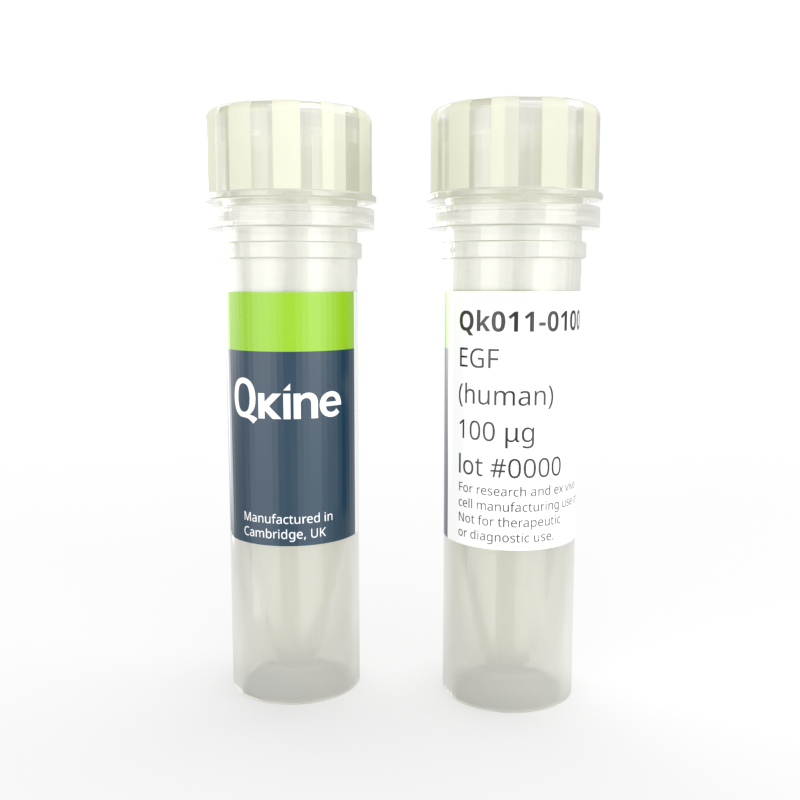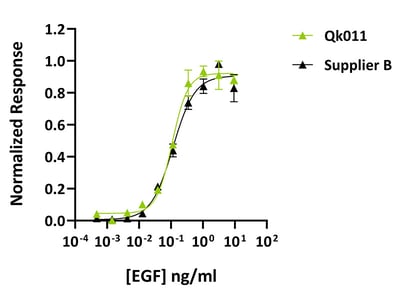Recombinant human EGF protein
QK011
Brand: Qkine
Human epidermal growth factor (EGF) protein is a potent EGF-family growth factor used in many human and mouse organoid and stem cell culture systems including intestinal and tumor organoid culture. EGF is also used in epithelial cell culture.
Qkine human EGF (Qk011) is a highly pure, animal origin-free, bioactive 6.3 kDa recombinant protein, making it ideal for use in chemically defined induced pluripotent stem cell (iPSC), embryonic stem cell (ESC) and organoid culture media.

Currency:
| Product name | Catalog number | Pack size | Price | Price (USD) | Price (GBP) | Price (EUR) |
|---|---|---|---|---|---|---|
| Recombinant human EGF protein, 100 µg | QK011-0100 | 100 µg | (select above) | $ 80.00 | £ 60.00 | € 71.00 |
| Recombinant human EGF protein, 500 µg | QK011-0500 | 500 µg | (select above) | $ 195.00 | £ 140.00 | € 164.00 |
| Recombinant human EGF protein, 1000 µg | QK011-1000 | 1000 µg | (select above) | $ 260.00 | £ 190.00 | € 222.00 |
Note: prices shown do not include shipping and handling charges.
Qkine company name and logo are the property of Qkine Ltd. UK.
Alternative protein names
Species reactivity
Human
Species similarity:
Porcine – 85%
Mouse – 74%
Rat – 70%
Summary
- High purity human EGF protein (residues 971-1023, Uniprot: P01133)
- 6.3 kDa
- >98%, by SDS-PAGE quantitative densitometry
- Expressed in E. coli
- Animal origin-free (AOF) and carrier protein-free
- Manufactured in our Cambridge, UK laboratories
- Lyophilized from acetonitrile, TFA
- Resuspend in 10 mM HCl (Reconstitution solution A) at >50 µg/ml, add carrier protein if desired, prepare single-use aliquots and store frozen at -20 °C (short-term) or -80 °C (long-term)
Featured applications
- Tumor organoid culture
Bioactivity
EGF activity was determined using the Promega serum response element luciferase reporter assay (*) in transfected HEK293T cells. Cells are treated in triplicate with a serial dilution of EGF for 3 hours. Firefly luciferase activity is measured and normalized to the control Renilla luciferase activity. EC50 = 11.6 pM (72.8 pg/mL). Data from Qk011 lot #10. *Promega pGL4.33[luc2P/SRE/Hygro] #E1340

Purity
EGF protein migrates as a single band at ~12 kDa in non-reducing (NR) and 9 kDa in reducing (R) conditions. Purified recombinant protein (7 µg) was resolved using 15% w/v SDS-PAGE in reduced (+β-mercaptothanol, R) and non-reduced conditions (NR) and stained with Coomassie Brilliant Blue R250. Data from Qk011 lot #011.

Further quality assays
- Mass spectrometry: single species with expected mass
- Recovery from stock vial: >95%
- Endotoxin: <0.005 EU/μg protein (below level of detection)

Qkine EGF is as biologically active as a comparable alternative supplier protein. Quantitative luciferase assay with Qkine EGF (Qk011, green) and alternative supplier EGF (Supplier B, black). Cells were treated in triplicate with a serial dilution of EGF for 3 hours. Firefly luciferase activity was measured and normalized to control Renilla luciferase activity. EC50s 0.11 ng/ml.
Protein background
Members of the human epidermal growth factor family are synthesized as type I transmembrane precursor proteins, often containing several EGF domains in the extracellular region. Proteolysis yields mature proteins that are released from the cell surface [1]. Epidermal growth factor binds to high-affinity EGF receptors (EGFRs) and promotes receptor dimerization and clustering leading to activation of downstream signaling pathways, including PI3K, ERK1/2, JAK/STAT, β-catenin, and calcium signaling [2].
Human epidermal growth factor (EGF) stimulates cell proliferation and differentiation. It is used extensively in induced-pluripotent stem cell (iPSC) and embryonic stem cell (ESC) culture systems for the successful expansion and differentiation of epithelial, neural, mesoderm and hematopoietic lineages [3]. EGF also stimulates the differentiation of mesenchymal stem cells (MSC) into bone-forming cells [4].
Recombinant EGF protein is a key component of many organoid media, along with other stem cell niche factors, R-Spondin 1, noggin or gremlin, Wnt3a and FGF-10. In addition, recombinant EGF is used for establishing and maintaining intestine, stomach, liver, pancreas, brain and cancer organoids [5].
Background references
- R. C. Harris, E. Chung and R.J. Coffey. EGF receptor ligands. Experimental cell research 284, 2–13 (2003). doi.org/10.1093/nar/14.21.8427
- G. Carpenter and S. Cohen. Epidermal growth factor. Journal of biological chemistry 265, 7709–7712 (1990). doi.org/10.1016/S0021-9258(19)38983-5
- A. G. Efthymiou, G. Chen, M. Rao, G. Chen and M. Boehm, M. Self-renewal and cell lineage differentiation strategies in human embryonic stem cells and induced pluripotent stem cells. Expert Opinion on Biological Therapy, 14(9), 1333–1344 (2014). doi.org/10.1517/14712598.2014.922533
- I. Kratchmarova, B. Blagoev, M. Haack-Sorensen, M. Kassem and M. Mann. Mechanism of Divergent Growth Factor Effects in Mesenchymal Stem Cell Differentiation. Science 308,1472-1477 (2005). doi:10.1126/science.1107627
- H. E. Abud, W. H. Chan and T. Jardé. Source and Impact of the EGF Family of Ligands on Intestinal Stem Cells. Front Cell Dev Biol. 2021 Jul 19;9:685665. doi: 10.3389/fcell.2021.685665
Publications using Recombinant human EGF protein (Qk011)
- Feeder-free culture of naive human pluripotent stem cells retaining embryonic, extraembryonic and blastoid generation potential
Rossignoli G, Oberhuemer M, Brun IS et al.
DOI: https://doi.org/10.1101/2025.01.17.633522 - Generation of human iPSC-derived pancreatic organoids to study pancreas development and disease
Darrigrand J-F, Isaacson A and Spagnoli FM
DOI: https://doi.org/10.1101/2024.10.24.620102 - A conserved differentiation program facilitates inhibitory neuron production in the developing mouse and human cerebellum Christensen JB, Donovan APA, Marzieh Moradi M et al.
DOI: doi.org/10.1101/2025.04.10.648162 - α-Ketoglutarate promotes trophectoderm induction and maturation from naive human embryonic stem cells
Van Nerum, K., Wenzel, A., Argemi-Muntadas, L. et al.
DOI: doi.org/10.1038/s41556-025-01658-1